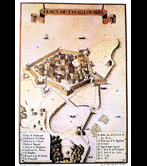Hondarribia’s defensive wall
The city wall is a characteristic feature of the villas. It is at once defensive and symbolic, as it distinguishes (economically, judicially etc) those who live on the inside, and those without. In Gipuzcoa, a large number of them were integrated into the urban fabric to the point where the walls began to lose their purpose, or were pulled down in the 19th century to meet the new demands of the city (as was the case in Donostia) but some vestiges remain of which the most important, without doubt, are those in Hondarribia.
This fortified town was subjected to a series of sieges and occupations, above all in the confrontations between the Catholic Kings and later, Austria, with France. Up until the middle of the 15th century, the province of Lapurdi (now the French départment of Labourd) belonged to the English Crown, and relations had in general been peaceful. The power struggles in Europe tended to be fought out in this small frontier town, as was the case with the siege of 1476. There were also sieges and invasions in 1512 and 1521 during the Castilian conquest of Navarra.
Hondarribia stands above the Bidasoa estuary, partially surrounded by the sea on the floodplain side, while on the lower side the mountainous and muddy ground made it difficult to approach on horseback. To this naturally defensive position were added the medieval walls and the castle, with its corresponding garrison and a governor whose job it was to defend the position on behalf of the King. He was responsible for maintaining the military-defensive life of the villa: the fortifications, garrison, supplies, provisions, and relations with several authorities. He was responsible for numerous works carried out on the walls.
Weapons development was matched by the development of the military architecture of Hondarribia. As was the case in Donostia, in the 16th century a barrier was built in front of the medieval walls as a shield against ever more accurate artillery. At the same time, artillery positions were also installed. The result was a complex system of walls, bastions, outposts and ditches that took up much of the space around the medieval town. In spite of various projects, little changed in the ensuing years in which work was centred more on maintaining and repairing the walls. The lack of new construction, in parallel with advances in armaments, rendered Hondarribia obsolete as a fortified town.
Hondarribia reflects the history of fortified towns and the point of transition between the medieval walled town and bastions of the 15th and 16th centuries; to the consolidation of new defensive systems in the second half of the 16th century; the alterations carried out in the Baroque era of the 17th century, especially after the siege of 1638, after which a series of modifications were incorporated into the external defences, and finally the period in which they were abandoned, beginning in the 18th century and reaching a peak in the 19th.
Further information here: "Fortifications in Gipuzkoa: 16th - 19th centuries" (Bertan Colection)
_petita.jpg)

%20OK%20p.jpg)

